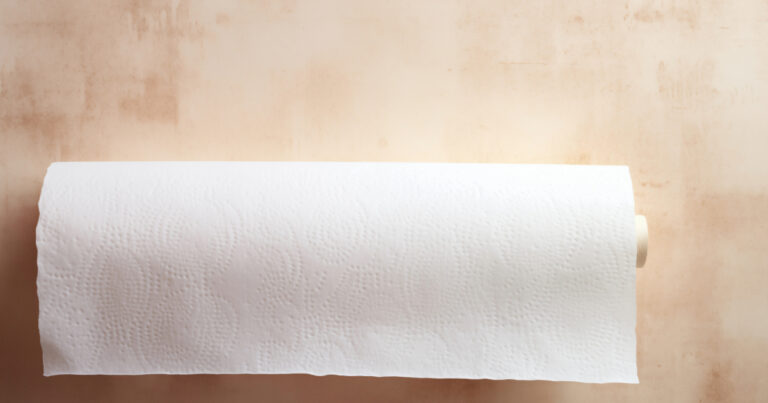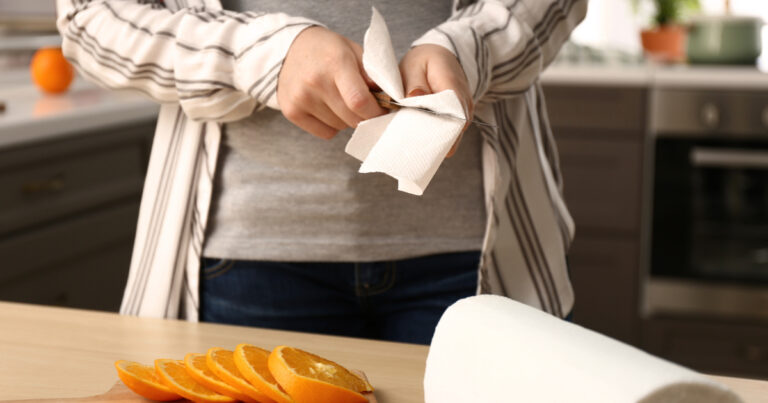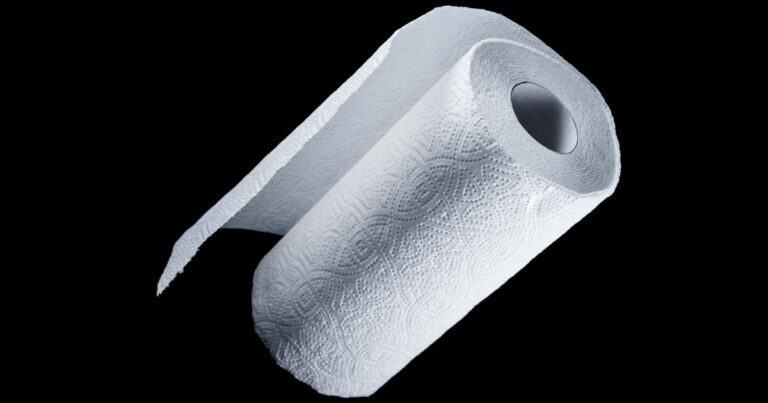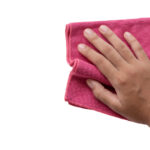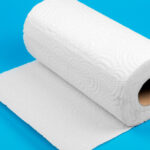When it comes to paper products for cleaning, paper towels and tissues have some overlap in functionality but are designed for different primary uses.

Understanding the key differences between these two household items can ensure you use the right product for the job.
What Are Paper Towels?
Paper towels are a thick, absorbent paper product designed for tasks like wiping up spills, cleaning surfaces, drying hands, and more. They are made from a woven fiber material that gives them durability and an ability to maintain integrity even when wet.
Paper towels come in sheet form or on rolls. Standard sheet sizes are around 11 x 11 inches while roll sizes range from 4 to 7 inches in diameter. They can be made from virgin wood pulp or recycled paper pulp. Most paper towel brands advertise features like high absorbency, strength, softness, and cleaning power.
Common brand names for paper towels include Bounty, Brawny, Viva, and Scott. In terms of fiber content, paper towels tend to have a higher percentage of long softwood fibers mixed in, which contributes to their wet strength. They also go through an embossing process that gives them texture and makes them better at picking up liquids and contaminants.
When it comes to usage, paper towels are a kitchen and cleaning workhorse. Typical uses include:
- Wiping up food and drink spills
- Cleaning countertops, appliances, sinks
- Drying hands
- Dusting and polishing furniture
- Absorbing grease while cooking
- Acting as makeshift napkins at informal meals
Paper towels are not recommended for facial use or as a toilet paper substitute, as they can be rough on skin and do not break down well in plumbing. They also have higher environmental impact compared to other paper products due to extensive use and low recycling rates. However, they fill an important cleaning niche.
Key Takeaway: Paper towels are an absorbent and durable paper product used primarily for cleaning tasks.
What Are Tissues?
Tissues are thin, soft sheets of absorbent paper designed primarily for hygiene and facial care rather than cleaning. The main types are facial tissues and toilet tissues. Facial tissues can also sometimes be referred to as portable tissues.
Facial tissues are sold in boxes in sizes like standard (8.3 x 8.3 inches) and large (9.2 x 8.4 inches). They can feature added ingredients like oils, lotions, and scents to prevent skin irritation from frequent nose blowing. Toilet tissue comes in rolls with diameters ranging from 4 to 5 inches for standard rolls and 6 to 7 inches for larger “jumbo” sizes.
Tissues are typically white in color and made from wood pulp, recycled paper pulp, or blended pulp sources. Compared to paper towels, they have shorter fibers and lower basis weights, giving them softness and disposability rather than scrubbing power. They also lack the embossing and creping in paper towels that increase absorbency. However, tissues contain chemical binders to give them wet strength for their intended usage.
Common uses for facial tissues include:
- Blowing and wiping nose
- Wiping eyes when watery or crying
- Cleaning up coughs and sneezes
- Applying makeup remover
- Wiping babies’ faces
Toilet tissue has the solitary use of hygienic cleansing after bathroom use. Special lotions and scents are less common in toilet tissue.
A key property of tissues is fast breakdown when flushed or discarded. As they lack durability for cleaning tasks, tissues serve a specific hygiene market niche.
Key Takeaway: Tissues are soft, absorbent paper products designed mainly for hygiene and facial care tasks rather than cleaning.
Table comparing paper towels and tissues:
| Property | Paper Towels | Tissues |
|---|---|---|
| Primary Use | Cleaning/Absorbing | Hygiene/Facial Care |
| Wet Strength | High | Low-Medium |
| Softness | Low-Medium | High |
| Absorbency | High | Low-Medium |
| Common Sizes | 11” x 11” sheets, 4-7” rolls | 8-9” square boxes, 4-5” toilet rolls |
| Fiber Content | Long softwood, virgin pulp | Short hardwood, recycled pulp |
| Texture | Embossed, creped | Smooth |
| Sustainability | Low – high waste | Medium – some recycled content |
Direct Comparison of Paper Towels vs Tissues
Now that we’ve covered the basics of what each product is, let’s dive into a head to head comparison of some key differences:
Materials
- Paper Towels: Made from virgin wood pulp or recycled pulp. Contain a higher percentage of long softwood fibers that provide wet strength. These are combined with shorter hardwood fibers, cotton linters, or fabric scraps.
- Tissues: Typically made from shorter hardwood paper fibers or recycled paper content. Can have small amounts of softwood pulp added for durability. Whitened using bleach.
Design and Texture
- Paper Towels: Large sheets or perforated rolls. Very textured surface created through processes like creping and embossing to improve liquid absorption and scrubbing ability.
- Tissues: Smooth, lightweight surface optimized for gentleness and disposability. Often scented or medicated to prevent skin irritation. Toilet tissue comes in rolls, facial tissue in boxes.
Production and Sustainability
- Paper Towels: Take significant fresh water and tree resources to produce. Bleaching and processing increase energy usage. Low recycling rates mean most end up in landfills. Considered least eco-friendly paper product.
- Tissues: Have higher recycled paper content and lighter basis weights requiring fewer resources. Toilet tissue often uses less desirable recycled materials like old magazines and scrap. More likely to be flushed or decompose rather than fill landfills.
Use Cases
- Paper Towels: Cleaning spills, windows, counters, appliances. Grease absorption while cooking. Can be improvised as informal napkins. Higher durability suits them to heavy-duty cleaning and reuse.
- Tissues: Facial hygiene and care including blowing nose, wiping eyes, applying cosmetics. Toilet tissue exclusively for bathroom use due to fast decomposition in water and risks of plumbing issues. Too weak for cleaning tasks.
Cost
- Paper Towels: More expensive per unit than tissues. Brands emphasize performance features that come at a higher price: strength, softness, absorbency. Durability provides some reuse potential.
- Tissues: Cheaper per unit than paper towels. Designed as a disposable product with cost savings passed to consumer. Exceptions include boutique facial tissues with lotions, perfumes etc.
As this comparison shows, paper towels excel at absorbing liquid and withstanding vigorous cleaning tasks, while tissues are specially formulated to be gentle on facial skin and break down rapidly after use.
Understanding these specialized roles can prevent the all-too-common problem of grabbing a tissue when what you actually need is a sturdy paper towel, or vice versa!
Key Takeaway: Paper towels focus on absorbency and wet strength for cleaning tasks while tissues focus on gentleness and easy disposability for personal and facial hygiene needs.
Can You Use Paper Towels as Toilet Paper?
Because of their appearance and absorbency, some people wonder whether paper towels can substitute for toilet paper in a pinch. However, there are a few good reasons why you typically do not want to use paper towels in place of TP:
- Plumbing Issues: Unlike toilet paper, paper towels are not designed to break down rapidly in water. Using them in place of TP can create blockages and clogged pipes over time.
- Sewer Problems: Paper towel fibers that make it through the initial pipes can still accumulate in public sewer systems, causing headaches for waste management.
- Lack of Softness: Paper towels lack the softened fiber content of toilet paper and can be rough and abrasive on delicate skin. Definitely not a great replacement option when other alternatives exist!
- Higher Cost: Buying paper towels just for toilet use would be quite wasteful and expensive compared to purchased toilet paper.
- Increased Waste: Heavy reliance on paper towels for bathroom purposes would greatly increase landfill waste and associated issues compared to recyclable TP products.
So while paper towels may technically get the job done in a pinch, making a habit of flushing them can create problems over time, especially at scale in commercial buildings and public restrooms. Instead, keep a bathroom well stocked with soft, septic-safe TP designed specifically for the task!
Key Takeaway: It’s not recommended to use paper towels in place of toilet paper on a regular basis due to plumbing, cost, comfort, and waste issues.
FAQs
Are paper towels flushable?
No – while small amounts may pass through home plumbing without issue, paper towels will eventually clog pipes, sewers, and septic tanks if flushed repeatedly. Always dispose of used paper towels in the trash.
Can you flush toilet paper alternatives like tissues?
Sometimes – tissues technically can be flushed but may not dissolve as rapidly as toilet paper. Facial tissues should always go in the trash instead when possible. Even when designed as flushable, alternatives like “flushable wipes” frequently cause problems in waste water systems. Standard toilet paper is still the best option.
How many times can you reuse a paper towel?
Paper towels can typically be reused (with caution) 1-2 times if not overly soiled. For light tasks like drying hands or dusting, give them a quick inspection and reuse gently. Discard immediately if dripping wet, dirty, or worn out. Reusing them too often increases chances of cross-contamination or leaving filmy residue on surfaces. When in doubt, grab a fresh one!
Do paper towels kill germs and disinfect?
Basic paper towels absorb rather than kill most germs. Using them is still effective for cleaning because physical removal decreases the viral and bacterial load in an environment overall. However, they don’t replace the disinfecting power of cleaners designed specifically to eliminate germs and microbes.
How do small businesses reduce paper towel waste?
Some tips include:
- Install energy efficient hand dryers where practical
- Switch to dish towels and sponges for light cleaning tasks
- Provide reusable cloth towels rather than paper next to sinks
- Look for high-capacity, controlled-use paper towel dispensers
- Set limits on number of paper towels issued per person
- Train staff to reuse towels for small spills before disposal
- Provide centralized waste stations for efficient collection
Conclusion
Paper towels and tissues may seem nearly identical – after all, they both involve absorbent sheets of paper!
But looking closely, each product offers specialized traits making them uniquely suited for certain applications. The key is choosing the right tool for the job.


